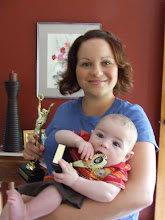 So, my adventures as an E-Learning Manager have, for the moment, come to an end. It has been interesting, exciting, relevant and at times excruciating. As a Learning Manager in the 21st Century, I have developed an understanding of the importance of keeping track of rapidly evolving technologies. It is of my opinion that students need to be looked at as the future of society, and it is our responsibility as educators to provide them with opportunities that will both foster and extend their abilities.
So, my adventures as an E-Learning Manager have, for the moment, come to an end. It has been interesting, exciting, relevant and at times excruciating. As a Learning Manager in the 21st Century, I have developed an understanding of the importance of keeping track of rapidly evolving technologies. It is of my opinion that students need to be looked at as the future of society, and it is our responsibility as educators to provide them with opportunities that will both foster and extend their abilities.Learning involves the ability to "maintain an open mind". (Marzano & Pickering, 1997). Marzano and Pickering (1997) argue that open-mindedness extends our knowledge base as well as enhancing our communication skills. To really understand the social diversity and technological abilities of our learners, we too must maintain an open mind and use materials which are relevant to the children in our classrooms.
Hargreaves (2001) suggests that teachers in today’s society must find a way to move forward with technology to better equip themselves and produce better teaching practices. This is done by creatively exploring and testing out what will work better for the children in their classrooms. Hargreaves (2001) also argues that effective teachers will seek professional opinions and guidance from others around them. I have found this to be extremely important during my blogging experiences. Collaboration with like-minded people can help to untangle complicated issues.
During my journey, I explored many technologies that would be of great benefit to me in my teaching career. All of these technologies I can imagine would be highly engaging for most students, though the tools that stood out the most to me were:
• Interactive whiteboards;
• Google Earth;
• WebQuests; and
• Avatars.
Interactive whiteboards have proven to me to be a wonderfully interactive learning tool. I have witnessed them being used in many subject areas, with the children continually wanting to try it out for themselves. During my allocated prac lessons, I have come across many websites which suggest possible teaching methods when using an interactive whiteboard. One such website suggests that “interactive whiteboards are becoming increasingly useful with a wide range of software to help you teach subjects in new and stimulating ways.” (Interactive Whiteboard Lessons, 2006).
Google Earth offers an alternative to mediocre globe which should be found in all classrooms. This tool provides students with a hands-on learning experience, which many constructivist theorists will argue is a vital aspect to effective learning. One such theorist is Kegan (1982), who believes that “learning is highly tuned to the situation in which it takes place”. With this in mind, would students be more likely to learn from viewing 3D images of the world from Space, or from a dusty globe?
The use of WebQuests in the classroom is one that I am definitely looking forward to implementing in future practice. The Queensland Department of Education and Training (2004), suggest that students must feel a sense of “connectedness to the world”. WebQuests are an excellent way to do this, as students can be confronted with real-life problems within their community and work together to come up with practical solutions.
Avatars provide an exciting ‘new teacher’ in the classroom, rather than listening to the Learning Manger constantly. Marzano and Pickering (1997) argue that for students to develop positive attitudes and perceptions towards classroom task, means to provide them with a multiplicity of ways to engage them. “Few would argue that when students are highly engaged in tasks, they learn more”. (Marzano and Pickering, 1997). This may pose as challenging for many teachers, however Avatars offer a simple initial solution to this problem.
After perusing many of my fellow BLM students’ blog postings, I have developed a barrage of ideas and resources to incorporate into my teaching strategies. Keeping this in mind, I realise that it is essential that I continue to search for new and interesting ways to connect to my students and enable me to enhance my comprehension of the ‘digital native’ language.
As all other teaching strategies, the use of technology should never stand alone in the delivery of information. To achieve outcomes in all learners means to cater for all learning styles. Not all students will be confident using a computer, let alone the Internet. We must not be naive to the fact that although our students were born as ‘digital natives’ they may still require responsible guidance when undertaking technology based tasks.
Regards,
Erin.
Sources:
Department of Education and Training. (2004). New Basics Project: Connectedness to the World. [Electronic resource]. (http://education.qld.gov.au/corporate/newbasics/html/pedagogies/connect/con3a.html). Retrieved 20 August 2009.
Hargreaves, D. (2001). Creative professionalism: The role of teachers in the knowledge society. London, UK: Demos.
Interactive Whiteboard Lessons. (2006). Smart Board Lessons In The Classroom & Smart Board Info. Interactive Whiteboards. [Electronic resource] (http://www.interactivewhiteboardlessons.org/). Retrieved 20 August 2009.
Kegan, R. (1982). The evolving self: Problem and process in human development. Cambridge, MA: Harvard University Press.
Marzano, R.J.; Pickering, D.J.; Arredondo, D.E.; Blackburn, G.J.; Brandt, R.S.; Moffett, C.A.; Paynter, D.E.; Pollock, J.E. & Whisler, J.S. (1997). Dimensions of Learning: Teacher’s Manual. Colorado, USA: McREL.














